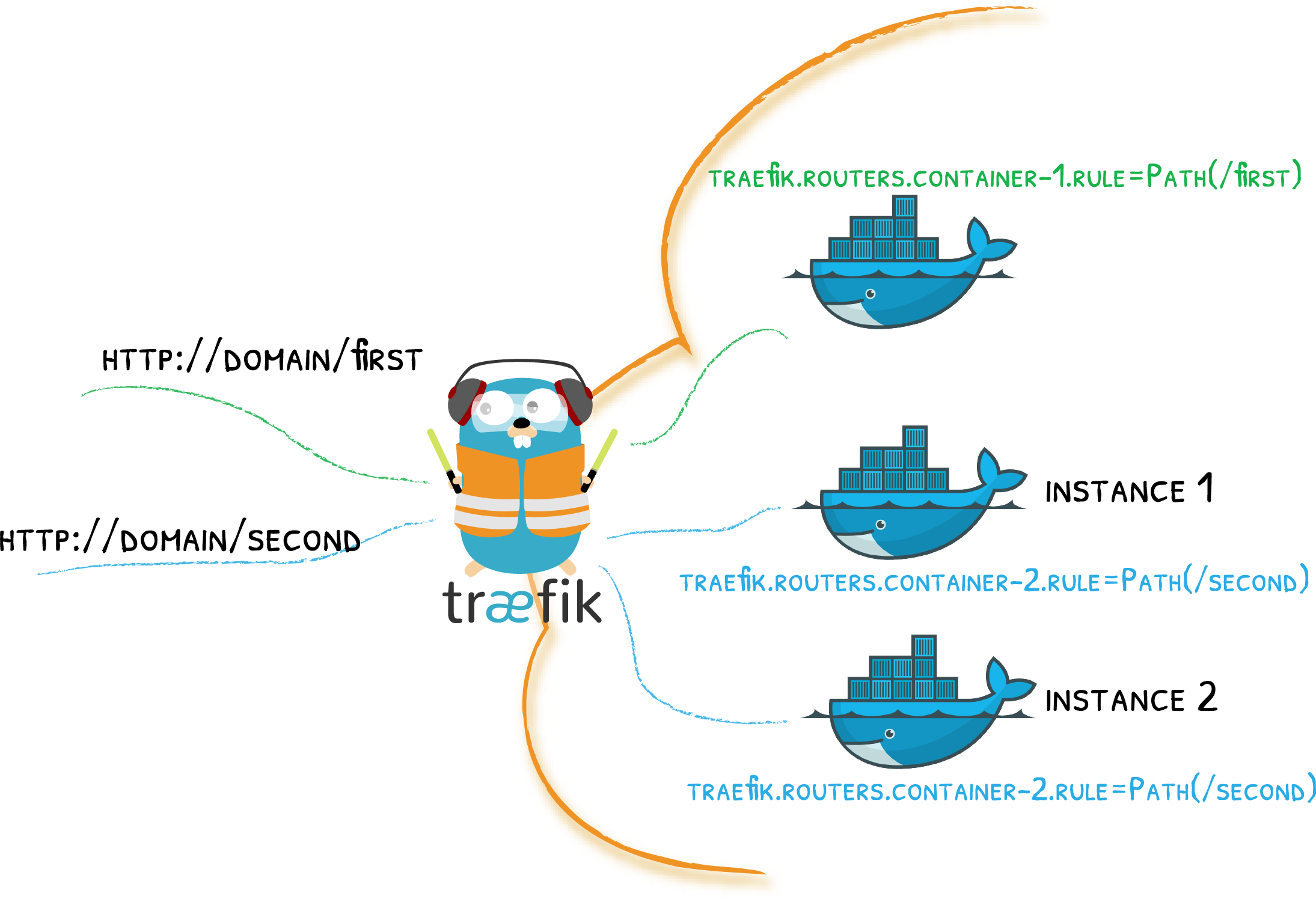Beginner-Guide: Traefik & Docker Swarm
How Traefik Works with Docker Swarm
Traefik integrates tightly with Docker Swarm, using the Docker API to automatically discover services. In Swarm Mode, Traefik watches for service-level labels rather than container-level labels (which are used in standalone Docker mode). This allows Traefik to dynamically adapt as services are created, updated, or removed.
Benefits of Using Traefik with Docker Swarm:
- Dynamic Service Discovery: Traefik automatically finds and configures services based on Docker labels, which eliminates the need for manually updating configuration files.
- Scalability: Traefik automatically adjusts routing as new instances of services are scaled up or down.
- Real-Time Updates: As services are added or removed in Swarm, Traefik updates routing rules without needing restarts or manual intervention.
Example: Deploying Traefik with Docker Swarm
Let’s walk through an example where we deploy Traefik as a reverse proxy in a Docker Swarm environment. We’ll expose a simple web service and configure routing with labels.
1. Setting Up Traefik in Docker Swarm
First, we need to deploy Traefik as a service in the Docker Swarm cluster. Traefik requires access to the Docker socket to monitor the containers and services. Here's how to deploy Traefik with Docker Swarm using Docker Compose:
version: '3.7'
services:
traefik:
image: traefik:v3.0
command:
- "--api.insecure=true" # Exposes Traefik's dashboard
- "--providers.docker=true" # Enables Docker as the provider
- "--entrypoints.web.address=:80" # Defines an HTTP EntryPoint on port 80
ports:
- "80:80" # Expose Traefik's HTTP EntryPoint
- "8080:8080" # Expose the Traefik Dashboard
volumes:
- "/var/run/docker.sock:/var/run/docker.sock" # Access Docker API
deploy:
placement:
constraints:
- node.role == manager # Only run on Swarm manager nodesExplanation:
providers.docker=true: Enables Traefik to use Docker as a provider.entrypoints.web.address=:80: Defines an HTTP EntryPoint listening on port 80.api.insecure=true: Enables Traefik's web dashboard (only for demonstration purposes, not recommended in production).
2. Deploying a Service with Routing Labels
Next, let’s deploy a simple web service, such as Nginx, and attach routing labels so that Traefik can automatically route traffic to it.
version: '3.7'
services:
nginx:
image: nginx
deploy:
labels:
- "traefik.enable=true"
- "traefik.http.routers.nginx.rule=Host(`nginx.local`)"
- "traefik.http.services.nginx.loadbalancer.server.port=80"Explanation:
traefik.enable=true: Tells Traefik to expose this service.traefik.http.routers.nginx.rule=Host('nginx.local'): Defines a routing rule that routes requests with theHostheadernginx.localto this service.traefik.http.services.nginx.loadbalancer.server.port=80: Specifies the internal port for Nginx.
Now, you can deploy this configuration in your Swarm cluster with:docker stack deploy -c docker-compose.yml my-stack
Or you can run the Stack in Portainer :)
Understanding Key Configuration Elements
Port Detection in Docker Swarm
Traefik does not automatically detect ports in Docker Swarm mode. You must explicitly set the port label (traefik.http.services.<service_name>.loadbalancer.server.port) to tell Traefik which port to use for the service. This ensures that Traefik can properly route requests to the service.
Host Networking with Traefik
If you are exposing containers configured with host networking, Traefik resolves the host IP based on the following priorities:
host.docker.internalhost.containers.internal- If both fail, it falls back to
127.0.0.1.
IPv4 and IPv6
By default, Traefik prioritizes the IPv4 address of a container, even in an IPv6-enabled Docker stack. If you want Traefik to use the IPv6 address, make sure your Docker configuration supports IPv6 routing.
Scheduling Traefik on Swarm Nodes
In Docker Swarm mode, only manager nodes can access the Docker Swarm API, which Traefik needs to dynamically discover services. Therefore, you must schedule Traefik on manager nodes. Here’s how to do it:
Example for Docker Compose:
services:
traefik:
image: traefik:v3.0
deploy:
placement:
constraints:
- "node.role == manager"Docker API Access and Security Considerations
Since Traefik requires access to the Docker API via the docker.sock socket, this raises potential security risks. Anyone with access to Traefik can also gain access to the Docker API and, by extension, the underlying host. To mitigate this risk:
- Only expose the Docker socket to trusted services.
- Consider securing the Docker socket with a TLS connection.
Here’s an example of a secure Docker API configuration with TLS:
providers:
swarm:
tls:
cert: "/path/to/cert.crt"
key: "/path/to/key.key"
ca: "/path/to/ca.crt"This configuration ensures that the Docker API connection is secured using TLS.
Conclusion
Traefik’s integration with Docker Swarm provides a powerful, dynamic solution for managing services at scale. By using labels on services, Traefik can automatically discover, configure, and route traffic without the need for manual intervention. It’s particularly useful for dynamic environments where services are frequently added or removed, as Traefik handles these changes in real time.
This beginner-friendly overview of Traefik with Docker Swarm should give you a solid foundation for deploying and routing your services dynamically. As you become more familiar, you can explore advanced configurations such as load balancing strategies, security features, and using external providers like Kubernetes.



No Comments